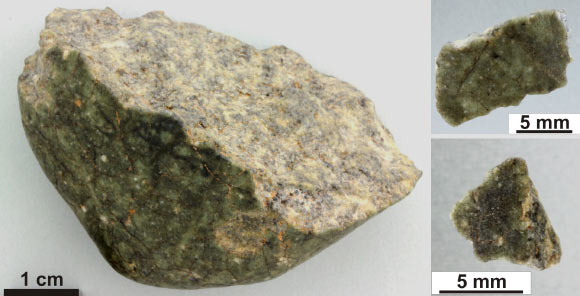A team of researchers in Europe has identified a new high-pressure mineral in a lunar meteorite called Oued Awlitis 001.
Oued Awlitis 001 is a feldspatic lunar meteorite that was found in 2014 in Western Sahara, Africa.
The main fragment of the space rock, originally 382 g, was found on January 15, 2014 by a group of eight travelers. It is largely covered with a green to brownish fusion crust showing features of orientation.
Another fragment, 50.5 g, fitting the larger one, was found a few weeks later; ~60% of it is covered with a crackled fusion crust and shows a rollover lip on one side. Two other fragments, 497 mg and 148 mg, were also found.
Oued Awlitis 001 is classified as an anorthositic lunar impact melt rock, composed of large anorthite clasts set in a poikilitic matrix of plagioclase, olivine, and pyroxene.
Scientists think that this meteorite was ejected from the Moon about 300,000 years ago.
“This meteorite is compositionally similar to rocks comprising the Earth’s continents,” said lead author Dr. Jörg Fritz from the Zentrum für Rieskrater und Impaktforschung in Germany and his colleagues.
“Eroded sediments from these continents are transported by wind and rivers to the oceans, and subducted into the Earth’s mantle as part of the dense oceanic crust.”
“While being dragged deeper into the Earth mantle the pressure and temperature increases, and the minerals transform into denser mineral phases.”

This SEM image shows crystals of donwilhelmsite in Oued Awlitis 001. Image credit: Ansgar Greshake, Museum für Naturkunde Berlin.
The newly-discovered extraterrestrial mineral, named donwilhelmsite, is a high-pressure silicate with a formula of CaAl4Si2O11.
Its name honors USGS geologist Don E. Wilhelms for his seminal and groundbreaking work on the geological history of the Moon.
The needle-shaped crystals of donwilhelmsite were found in 200-mm-sized shock melt pockets of the Oued Awlitis 001 meteorite.
“Donwilhelmsite is the first high-pressure mineral found in meteorites with application for subducted terrestrial sediments,” the scientists said.
“It is mainly composed of calcium, aluminum, silicon, and oxygen atoms.”
The structure of donwilhelmsite was solved with precession-assisted 3D electron diffraction.
“The identification of donwilhelmsite in a lunar meteorite underlines that high-pressure phase formation in localized zones of shock melt in meteorites is a common phenomenon,” the authors said.
“The natural occurrence of high-pressure phases is an important asset to understand geological processes affecting the magmatic evolution of terrestrial planets, such as phase transformations in planetary interiors, magma ocean crystallization, and plate tectonics.”
“In the Earth’s mantle, donwilhelmsite forms during deep recycling of aluminous crustal materials, which are also rich in volatiles and other elements incompatible in mantle minerals.”
“In the terrestrial rock cycle, donwilhelmsite is an important agent for transporting crustal sediments through the transition zone and uppermost lower mantle (460-700 km).”
The discovery is described in a paper published in the journal American Mineralogist.
_____
Jörg Fritz et al. 2020. Donwilhelmsite, [CaAl4Si2O11], a new lunar high-pressure Ca-Al-silicate with relevance for subducted terrestrial sediments. American Mineralogist 105 (11): 1704-1711; doi: 10.2138/am-2020-7393








